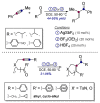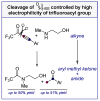Alkynes as Synthetic Equivalents of Ketones and Aldehydes: A Hidden Entry into Carbonyl Chemistry
- PMID: 30875972
- PMCID: PMC6471418
- DOI: 10.3390/molecules24061036
Alkynes as Synthetic Equivalents of Ketones and Aldehydes: A Hidden Entry into Carbonyl Chemistry
Abstract
The high energy packed in alkyne functional group makes alkyne reactions highly thermodynamically favorable and generally irreversible. Furthermore, the presence of two orthogonal π-bonds that can be manipulated separately enables flexible synthetic cascades stemming from alkynes. Behind these "obvious" traits, there are other more subtle, often concealed aspects of this functional group's appeal. This review is focused on yet another interesting but underappreciated alkyne feature: the fact that the CC alkyne unit has the same oxidation state as the -CH2C(O)- unit of a typical carbonyl compound. Thus, "classic carbonyl chemistry" can be accessed through alkynes, and new transformations can be engineered by unmasking the hidden carbonyl nature of alkynes. The goal of this review is to illustrate the advantages of using alkynes as an entry point to carbonyl reactions while highlighting reports from the literature where, sometimes without full appreciation, the concept of using alkynes as a hidden entry into carbonyl chemistry has been applied.
Keywords: acetals; aldehydes; alkynes; carbonyl compounds; catalysis; condensations; cyclizations; electronic structure; ketones; nucleophilic addition; rearrangements.
Conflict of interest statement
The authors declare no conflict of interest.
Figures















































Similar articles
-
Unexpected regioselective carbon-hydrogen bond activation/cyclization of indolyl aldehydes or ketones with alkynes to benzo-fused oxindoles.Nat Commun. 2014 Sep 25;5:5030. doi: 10.1038/ncomms6030. Nat Commun. 2014. PMID: 25255198
-
Nickel-catalyzed cycloadditions of unsaturated hydrocarbons, aldehydes, and ketones.J Org Chem. 2008 Apr 4;73(7):2641-8. doi: 10.1021/jo702508w. Epub 2008 Mar 5. J Org Chem. 2008. PMID: 18318544 Free PMC article.
-
Rhodium-catalyzed direct annulation of aldehydes with alkynes leading to indenones: proceeding through in situ directing group formation and removal.Org Lett. 2013 Sep 20;15(18):4754-7. doi: 10.1021/ol4021145. Epub 2013 Sep 6. Org Lett. 2013. PMID: 24011165
-
Intermolecular Metal-Catalyzed Reductive Coupling of Dienes, Allenes, and Enynes with Carbonyl Compounds and Imines.Chem Rev. 2018 Jun 27;118(12):6026-6052. doi: 10.1021/acs.chemrev.8b00213. Epub 2018 Jun 13. Chem Rev. 2018. PMID: 29897740 Free PMC article. Review.
-
Diastereoselective allylation of carbonyl compounds and imines: application to the synthesis of natural products.Chem Rev. 2013 Jul 10;113(7):5595-698. doi: 10.1021/cr400008h. Epub 2013 Mar 29. Chem Rev. 2013. PMID: 23540914 Review. No abstract available.
Cited by
-
Bismuth Subnitrate-Catalyzed Markovnikov-Type Alkyne Hydrations under Batch and Continuous Flow Conditions.Molecules. 2021 May 12;26(10):2864. doi: 10.3390/molecules26102864. Molecules. 2021. PMID: 34066109 Free PMC article.
-
Electron-Deficient Alkynes as Powerful Tools against Root-Knot Nematode Melodogyne incognita: Nematicidal Activity and Investigation on the Mode of Action.J Agric Food Chem. 2020 Oct 7;68(40):11088-11095. doi: 10.1021/acs.jafc.0c00835. Epub 2020 Sep 24. J Agric Food Chem. 2020. PMID: 32924513 Free PMC article.
-
Design principles of the use of alkynes in radical cascades.Nat Rev Chem. 2023 Jun;7(6):405-423. doi: 10.1038/s41570-023-00479-w. Epub 2023 Mar 28. Nat Rev Chem. 2023. PMID: 37117812 Review.
-
L-Cysteine-Catalysed Hydration of Activated Alkynes.Angew Chem Int Ed Engl. 2025 Jan 10;64(2):e202414046. doi: 10.1002/anie.202414046. Epub 2024 Nov 6. Angew Chem Int Ed Engl. 2025. PMID: 39344480 Free PMC article.
-
Photocyclization of Alkenes and Arenes: Penetrating Through Aromatic Armor with the Help of Excited State Antiaromaticity.Chemistry (Basel). 2025 Jun;7(3):79. doi: 10.3390/chemistry7030079. Epub 2025 May 9. Chemistry (Basel). 2025. PMID: 40838095 Free PMC article.
References
-
- Chernick E.T., Tykwinski R.R. Carbon-rich nanostructures: The conversion of acetylenes into materials. J. Phys. Org. Chem. 2013;26:742–749. doi: 10.1002/poc.3160. - DOI
-
- Diederich F., Stang P.J., Tykwinski R.R. Acetylene Chemistry: Chemistry, Biology and Material Science. Wiley-VCH; Weinheim, Germany: 2005.
Publication types
MeSH terms
Substances
Grants and funding
LinkOut - more resources
Full Text Sources
Research Materials
Miscellaneous

